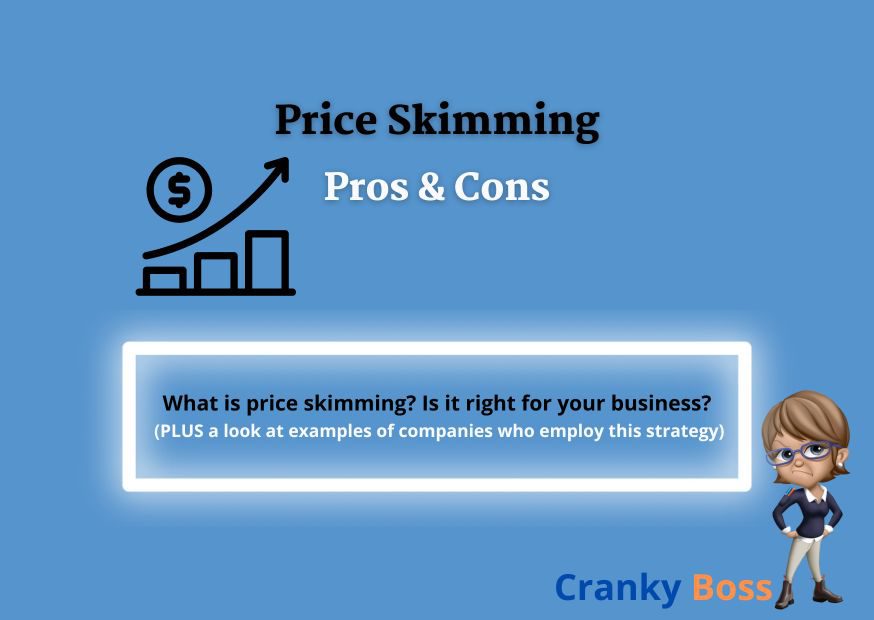Setting the right price for a product or service is crucial. One strategy that companies often use is called price skimming. This approach has its pros and cons, which we’ll take a look below.
What is Price Skimming?
Price skimming is a pricing strategy where a company sets a high initial price for a product or service and then gradually lowers it over time. This method is often used when a new product is introduced to the market and there’s high demand from early adopters or customers willing to pay a premium. Quite the opposite to penetration pricing.
Pros of Price Skimming
- Maximizing Profits: By starting with a high price, companies can capture the maximum amount of revenue from customers who are willing to pay more for the product.
- Recovery of Development Costs: Launching a new product often involves significant research and development (R&D) costs. By charging a high initial price, companies can quickly recover these costs, which is particularly important in industries with high upfront investments.
- Market Segmentation: Price skimming allows businesses to segment the market based on customers’ willingness to pay. Early adopters who are less price-sensitive pay more initially, while later price reductions can attract more price-sensitive customers.
- Brand Prestige and Exclusivity: A high initial price can create a perception of exclusivity and prestige around a product, enhancing the brand’s overall image. This can be particularly beneficial for luxury brands or products that are marketed as high-end.
- Managing Demand: For products that might have limited availability at launch (due to production constraints or other factors), a high initial price can help manage demand and prevent shortages. This ensures that the most eager and willing-to-pay customers get access first.
- Initial High Revenue: Early adopters who purchase the product at a high price contribute to a significant revenue stream right at the beginning of the product lifecycle. This influx of cash can be reinvested in marketing, further product development, or scaling up production.
- Signal of Quality: A high initial price can signal to customers that the product is of high quality or has unique features, which can help establish the product’s reputation in the market.
- Competitive Advantage: Price skimming can give a company a competitive advantage by allowing it to earn higher profits before competitors enter the market and prices start to decline.
Cons of Price Skimming
- Limited Market Reach: Setting a high price initially can limit the number of customers who can afford the product, which may slow down the rate of adoption in the market.
- Customer Perception of Price Drops: Frequent or significant price drops can lead to negative customer perceptions. Early buyers might feel cheated if the price drops shortly after their purchase, potentially harming brand loyalty. Managing your customers is one of the most important steps in running a successful business.
- Legal and Ethical Concerns: In some regions, price skimming might attract scrutiny from regulators if perceived as exploitative or unfair. There could be ethical concerns regarding the treatment of different customer segments.
- Market Entry Barriers: Market entry barriers are initially beneficial, but high prices can attract competitors. If a market sees high profitability, new entrants might rush in with similar products at lower prices, which could erode the market share quickly.
- Requires Strong Brand Positioning: Price skimming works best for brands with strong positioning and loyal customer bases. For newer or lesser-known brands, high initial prices without established brand value might drive customers away.
- Customer Wait for Price Drop: Savvy customers who are aware of price skimming strategies might delay their purchase until the price drops. This behavior can slow down the initial sales momentum.
- Inventory Management Challenges: Adjusting prices frequently can complicate inventory management and forecasting. It might be challenging to predict the right amount of stock needed at each price point, leading to either surplus or shortage.
- Short-Term Strategy: Price skimming is often seen as a short-term strategy, as competitors may quickly enter the market with lower-priced alternatives, eroding the company’s pricing power.
Is Price Skimming Right for Your Business?
Whether price skimming is the right strategy for your business depends on various factors, including the nature of your product, the level of competition in the market, and the preferences of your target customers. Understanding your target market is critical.
If you have a unique product with features that justify a premium price, and if you can effectively communicate the value proposition to your target market, then price skimming may be a viable option. However, if your product faces intense competition or if there’s a risk of competitors undercutting your prices quickly, then price skimming may not be the best approach. Price skimming can be considered a form of psychological pricing.
Examples of Price Skimming
- Apple: When Apple releases a new iPhone model, it typically starts with a high launch price, targeting early adopters who are willing to pay a premium for the latest technology. Over time, as demand wanes and competitors release similar products, Apple gradually lowers the price to attract a broader customer base.
- Gaming Consoles: Video game consoles like PlayStation and Xbox often use price skimming when they launch new hardware. These companies set high initial prices to capitalize on the enthusiasm of hardcore gamers and then lower prices over time to reach a wider audience.
- Tesla: Tesla uses price skimming when launching new models and innovative technologies. For example, the initial prices of the Model S and Model X were set high to target early adopters who valued the cutting-edge technology and status. Over time, Tesla introduced more affordable models like the Model 3 and Model Y, gradually reaching a broader market while maintaining premium prices for their high-end versions.
- Luxury Fashion Brands: Luxury fashion brands like Louis Vuitton or Gucci often use price skimming to position themselves as exclusive and premium. They start with high prices for their new collections, targeting affluent customers who value exclusivity, and then gradually reduce prices as the season progresses to attract a broader range of buyers.
Summing Up
Price skimming can be an effective pricing strategy for certain businesses, but it’s important to weigh the pros and cons carefully and consider the specific circumstances of your market before implementing it. Remember, due diligence is an important part of a business.
I implemented a price skimming strategy in my business to differentiate myself from cheap imitations. I focused on fewer sales but higher profit margins. Quality over quantity. Our customers were willing to pay a premium price for the superior quality, exclusivity and custom-made products, and exceptional customer service, something my competitors lacked.
This was key to the success of my business.

